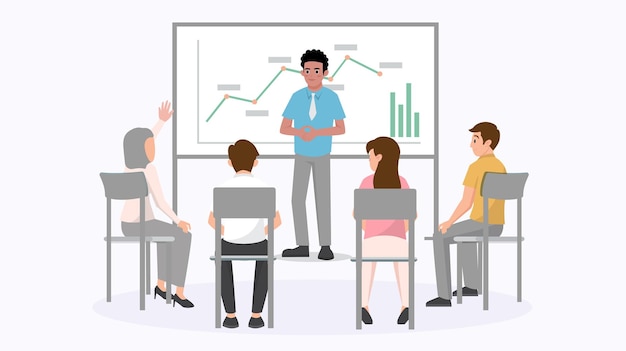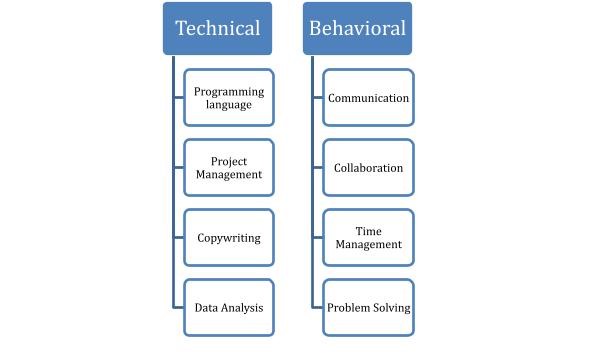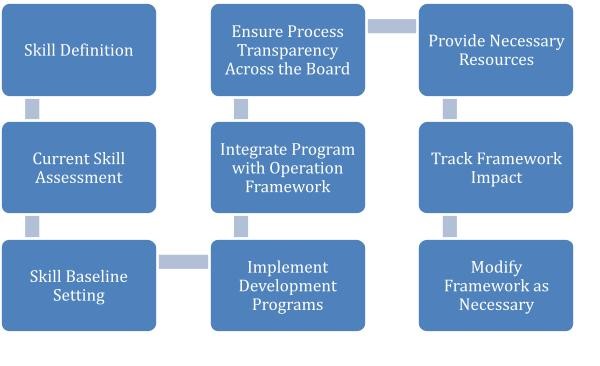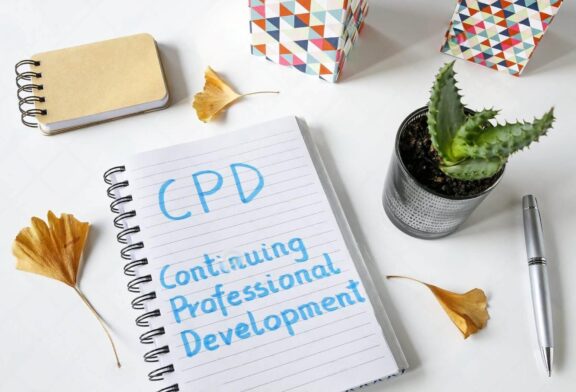Staying competitive is a top business priority, and an important part of achieving this is retaining a skilled and competent workforce. However, tracking the skill level of each and every worker, assigning them to relevant roles, and training them in the right skills can be a significant challenge. To address all of these, businesses can deploy a skills framework.

Maintaining relevance with skills required can be a challenge as business ecosystems are rapidly changing. 70% of global companies face a serious challenge in finding workers with the right skill set. Thus, skill-based recruitment and a greater stress on the skills of the present talent pool are essential.
To enable this, an essential tool is a skills framework that facilitates skill-based decision making, work assignments, and recruitments.
What is a Skills Framework?
A skills framework is an outline that identifies and defines each skill relevant to a job role, the necessary proficiency level, and lays out benchmarks to evaluate these skills. Thus, provides a structured system to serve as the knowledge and skills framework for any given role.
75% of those in management positions agree that the availability of the right talent is a major source of risk, while 72% believe that skill gaps among employees are among the biggest business challenges.
While they overlap, a skills framework is not identical to a competency framework.
Difference between Skills and Competency Frameworks
Skill frameworks outline specific, observable, and definable abilities that a worker needs to possess for a particular job role. Competency frameworks translate these into a broad, holistic structure, providing an understanding of both skills and attributes a worker needs to possess to perform well in a given role.
To better understand these differences, let’s look at the following table:
| Feature | Skills Framework | Competency Framework |
| Focus | Specific, measurable skills relevant to each job role. | Broader attributes that a worker needs to succeed in a role. |
| Scope | Task oriented | Role-specific and organisation-oriented |
| Nature | Abilities that are acquired by workers through training or experience. | Covers skills, knowledge, training, and behavioural attributes. |
| Applications | Used to assess and cultivate job-specific abilities. | Used to assess potential and suitability for a role. |
| Relationship to Each Other | Serve as the building blocks for competencies. | Integrates multiple skills into a common framework. |
Table 1: Skills Framework vs Competency Framework
Who Needs a Skills Framework?
According to a survey by McKinsey, 20 – 30% of roles do not have people with the right skills. A knowledge and skills framework has value for people in the following positions:
HR, Learning and Development, and Core Skills Training Teams
Skills framework plays a major role in the design of targeted training programs by HRMs and L&D teams. For instance, they can use an essential digital skills framework to ensure all their employees have the necessary digital skills for their role.
Executives and Strategic Decision-Makers
Skills frameworks help executives and decision makers align long-term business goals with the skills needed by the workers. For instance, a core skills training framework can help retrain employees, keeping them ready for future demands.
Managers and Operational Leaders
With suitable frameworks in place, managers and team leaders can assess the strengths of their workforce and identify where the teams are falling behind. This helps them guide professional development and make informed decisions regarding their team.
Employees and Individual Contributors
At an individual level, this helps the employees self-evaluate and gain clarity on their skills and competencies. Thus, it prompts the workers to address their developmental needs and improves performance.
Benefits of a Skills Framework for Organisations
Skills-based hiring enables efficient recruitment, the new hires often tending to stay longer with an organisation (9% longer tenure). Further, a 10x bigger talent pool can be accessed when recruiting with the help of a skills framework. Using a skills framework offers an organisation the following benefits:
Ensures Workforce Alignment and Strategic Workforce Planning
A skill framework can potentially outline which skills are necessary for a business to stay competitive. Then, it can be used to equip each employee, thus aligning the skills of the workforce to those needed by the business.
Facilitates Employee Development by Offering Training
At the individual level, the skills framework identifies where employees are falling short and additional skills that they require to progress to better roles. Then, companies can use this knowledge to design training programs for their employees.
Fosters Internal Mobility of the Workforce
Having proper skill training programs in place allows employers to quickly reskill their employees and place them in positions that can benefit the organisation. Thus, the organisation can quickly fill vacancies and maintain a competitive edge.
Streamlines Recruitment Using Competency Frameworks
When there is no suitable talent available within the organisation, the knowledge and skills framework guides the recruitment process. This framework helps create accurate job descriptions, helps evaluate the candidates, and streamlines the process.
Supports Performance Reviews and Appraisals
During the performance reviews, employers and employees can use the skills framework to ascertain which skills the employee has, their proficiency levels, and the ones they need to cultivate to support their growth and professional development.
5 Key Components of a Core Skills Training Framework
74% of organisations believe that reskilling their workers is essential in order to keep up with the changes in the industry. A skills training framework, at its core, will have the following components:
Skill Types
This sorts the skills into broad categories such as technical and behavioural skills that are necessary for a given role in an organisation.

Skill Levels
Defined for each worker, this sorts the staff into beginner, intermediate, advanced, and expert, depending on their capabilities.
Skill Description
This provides a clear outline of each skill, elaborating on its relevance, scope, and application, providing clarity with regards to a given skill.
Proficiency Indicators
These serve as markers and milestones for every skill, measuring every worker’s mastery in said skill and guiding skill development.
Applications
This sheds light on where and how the skills in question are being used for a role and in an organisation, thus providing the real-world use of the skills.
9 Steps to Build a Skills Builder Framework for Your Organisation

- To create an effective skills builder framework, the stepwise process to follow includes:
- Defining the essential skills for the role and business.
- Assessing the current skill levels of existing employees.
- Establishing a baseline for every skill to track and monitor it.
- Developing a training program that includes workshops and courses.
- Integrate this with the existing frameworks and HR systems in use.
- Communicate the purpose of the framework to the staff and ensure workforce buy-in.
- Provide resources and support, such as educational materials and mentorship programs.
- Track the progress and impact made by the framework.
- Evaluate and refine the framework to increase its effectiveness.
4 Practical Ways to Use a Skills Framework
As few as 14% organisations believe that the skills and capabilities of every worker are being used to their full potential, a fact that an adequate skills framework can help with. Once designed and deployed, a skills framework can serve the following four applications:
Career Planning and Progression
Based on the skills a particular employee has, the skill framework can be used to chalk out which career paths are available and enable informed decision-making.
Recruitment and Onboarding of New Employees
Using a skills framework makes it easier to align job roles to skills, ensuring accurate job descriptions and requirements, and enabling better recruitment and onboarding.
Employee Development and Training
With a skills framework, it is easier to identify skill gaps among employees and create targeted training programs that address specific skills.
Performance Management for the Workforce
The skills framework provides a uniform bar during performance management, rooting out skill gaps and providing objective and actionable feedback.
Common Challenges in Developing a Knowledge and Skills Framework
When laying out the structure for the knowledge and skills framework and deploying it, managers and HRMs may come across the following challenges:
Selecting the Right Skills for the Business
With the rapidly evolving business ecosystem, not all skills have equal relevance or will maintain their present relevance in the future. A consultation with the relevant stakeholders and industry experts can help gather insights on which skills to pick for the framework.
Ensuring Framework Consistency Across Teams
Defining skills across teams and departments can be a challenge, since proficiency requirements and relevance may vary, leading to disputes during evaluations. Thus, the framework should come with clear guidelines and criteria that are cross-functional and relevant.
Setting Skill Levels and Proficiency Metrics
Without benchmarks and indicators to measure proficiency levels, a skills framework can be subjective and open to bias. Thus, it must contain specific, quantifiable indicators to assess the skill level of every employee.
Driving Adoption Through Change Management
Transitioning to tools such as a skills framework can be a challenge when it comes to adoption across the organisation. Thus, communicating the changes, offering support, and training employees to use the skill framework is an essential part of change management.
How to Maximise the Impact of Your Skills Framework
To get the most out of the skills framework, HRMs can do the following:
- Integrate the skills framework into the business strategy and processes.
- Promote employee growth and engagement through skills development.
- Use this to create tailored development plans that boost an employee’s skillset.
- Review the framework and adjust it to maintain relevance.
Using Skills Frameworks With Efficiency
Designed well, a skills framework can integrate seamlessly with an organisation’s processes. For maximum efficacy, an organisation can integrate them with tech-based tools that track and monitor every worker automatically. This, in turn, will establish streamlined systems that offer business agility and long-term growth.
Interested in learning more? Check out the tools that can help design the skills framework.




